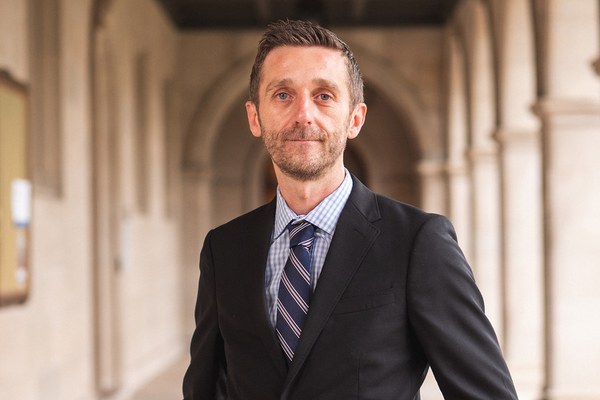Nicola Aravecchia, assistant professor of classics and of art history and archaeology at Washington University in St. Louis, was a fellow in Byzantine Studies in spring 2021. His research report, “Early Christianity in Egypt’s Western Desert: The Fourth-Century Church at Amheida,” summarized archaeological evidence of early Christian culture in the remote reaches of Egypt’s Western Desert.
Q&A with Nicola Aravecchia
What is unique about archaeological study in Egypt’s Dakhla Oasis?
The Dakhla Oasis is one of the most remote of the oases in Egypt’s Western Desert. It has preserved a considerable amount of evidence on early Christianity: sites along the Nile Valley, for example, have a history of more or less continuous occupation, so a lot of the evidence dated to the early Christian period in the first few centuries CE is obscured by evidence of later occupation. For reasons that are still not entirely clear, many sites in the Dakhla Oasis, by contrast, were abandoned around the end of the fourth century and the beginning of the fifth. They were never reoccupied, so many of the buildings have just been covered in sand, and when that is removed, we can get a pretty clear idea of the site before it was abandoned. Also, the fourth century is around the time architectural evidence of Christianity begins to appear in the archaeological record, like basilica-type churches. Much of this evidence comes from the Dahkla and the nearby Kharga Oases, which are ideal locations for preserving and thereby uncovering what the flourishing of early Christianity looked like in western Egypt.
What have your excavations in the oasis revealed?
I have devoted my research to this region since about 2005—I actually began working in Dakhla on the invitation of Robert Bagnall, after attending the 2004 Byzantine Studies symposium “Egypt and the Byzantine World, 450–700.” I started working at the site of Amheida and soon after became field director of the excavations at the site of ‘Ain el-Gedida. ‘Ain el-Gedida was a very small agricultural settlement of perhaps a few hundred people, but in this very small hamlet, we found one of the earliest known church complexes, from the beginning of the fourth century. We also found evidence of what was originally an Egyptian temple that appeared to have been remodeled into a ceramic workshop in the early Christian period, which tells us a lot about the afterlife of cult spaces in early Christianity.
In 2012, I rejoined the team at Amheida, where the excavation revealed another church, also dated to the fourth century. Amheida was a much bigger site than ‘Ain el-Gedida; fourth-century documents referred to it as a polis, meaning “city” in Greek. The excavation unfortunately remains incomplete due to the current political climate, but so far, we have found evidence of an underground funerary crypt below the apse and the north pastophorion (service room). Excavations at Amheida, under the direction of Paola Davoli, have also revealed considerable evidence for the ancient residents’ interest in Greco-Roman culture and life. For example, we unearthed the remains of a large public bath establishment in the Roman tradition, and in one of the rooms we even found evidence of tesserae for a mosaic that was never made. The tesserae were cut from sandstone, limestone, and broken ceramics—nothing too fancy like marble or glass—and were piled in one of the rooms. We also excavated a beautiful house belonging to a local councilmember named Serenos, containing painted scenes along classical themes like Perseus rescuing Andromeda and banqueting, which was one of the most important traditions of the classical world.
How do these findings add to our understanding of the region in late antiquity?
This evidence shows people in the Western Desert had adopted not only the Greek language, like much of the rest of Egypt at the time, but also the Greek cultural tropes and artistic forms. These remote locations had their own peculiarities, but they were also embedded in a broader cultural context, which is remarkable because of the remoteness. Even today, it takes more than ten hours to reach the Dakhla Oasis from Cairo, and one can imagine they were even more isolated in late antiquity, yet they were evidently connected with the rest of Egypt.
These excavations help us understand expressions of early Christianity in the region, as in the growing popularity of the basilica-type church in the Western Desert. Around the same time basilica types were adopted into Christian architecture in big cities like Rome and Constantinople, Christians in remote regions like the Dakhla Oasis adopted them, too. They evidently felt they belonged to the wider ecclesia and sought physical symbols of their faith. They would go to great lengths to do so: for example, the apse of the church we excavated at ‘Ain el-Gedida protruded into the nearby road, to the great inconvenience of anyone passing by; indeed, we found several grooves on the side of the church, likely indicating where passing animal carts had gotten stuck!
May Wang is postgraduate writing and reporting fellow at Dumbarton Oaks. Photo by Richard Tong, postgraduate digital media fellow.

